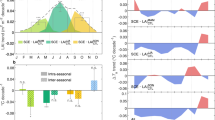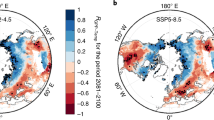Abstract
Temperature data over the past five decades show faster warming of the global land surface during the night than during the day1. This asymmetric warming is expected to affect carbon assimilation and consumption in plants, because photosynthesis in most plants occurs during daytime and is more sensitive to the maximum daily temperature, Tmax, whereas plant respiration occurs throughout the day2 and is therefore influenced by both Tmax and the minimum daily temperature, Tmin. Most studies of the response of terrestrial ecosystems to climate warming, however, ignore this asymmetric forcing effect on vegetation growth and carbon dioxide (CO2) fluxes3,4,5,6. Here we analyse the interannual covariations of the satellite-derived normalized difference vegetation index (NDVI, an indicator of vegetation greenness) with Tmax and Tmin over the Northern Hemisphere. After removing the correlation between Tmax and Tmin, we find that the partial correlation between Tmax and NDVI is positive in most wet and cool ecosystems over boreal regions, but negative in dry temperate regions. In contrast, the partial correlation between Tmin and NDVI is negative in boreal regions, and exhibits a more complex behaviour in dry temperate regions. We detect similar patterns in terrestrial net CO2 exchange maps obtained from a global atmospheric inversion model. Additional analysis of the long-term atmospheric CO2 concentration record of the station Point Barrow in Alaska suggests that the peak-to-peak amplitude of CO2 increased by 23 ± 11% for a +1 °C anomaly in Tmax from May to September over lands north of 51° N, but decreased by 28 ± 14% for a +1 °C anomaly in Tmin. These lines of evidence suggest that asymmetric diurnal warming, a process that is currently not taken into account in many global carbon cycle models, leads to a divergent response of Northern Hemisphere vegetation growth and carbon sequestration to rising temperatures.
This is a preview of subscription content, access via your institution
Access options
Subscribe to this journal
Receive 51 print issues and online access
$199.00 per year
only $3.90 per issue
Buy this article
- Purchase on Springer Link
- Instant access to full article PDF
Prices may be subject to local taxes which are calculated during checkout




Similar content being viewed by others
References
Solomon, S., et al. (eds) Climate Change 2007: The Physical Science Basis. Contribution of Working Group I to the Fourth Assessment Report of the Intergovernmental Panel on Climate Change (Cambridge Univ. Press, 2007)
Atkin, O. et al. Light inhibition of leaf respiration as soil fertility declines along a post-glacial chronosequence in New Zealand: an analysis using the Kok method. Plant Soil 367, 163–182 (2013)
Keeling, R. F., Piper, S. C. & Heimann, M. Global and hemispheric CO2 sinks deduced from changes in atmospheric O2 concentration. Nature 381, 218–221 (1996)
Myneni, R. B., Keeling, C. D., Tucker, C. J., Asrar, G. & Nemani, R. R. Increased plant growth in the northern high latitudes from 1981 to 1991. Nature 386, 698–702 (1997)
Zhou, L. M. et al. Variations in northern vegetation activity inferred from satellite data of vegetation index during 1981 to 1999. J. Geophys. Res. 106, 20069–20083 (2001)
Nemani, R. R. et al. Climate-driven increases in global terrestrial net primary production from 1982 to 1999. Science 300, 1560–1563 (2003)
Beier, C. et al. Carbon and nitrogen cycles in European ecosystems respond differently to global warming. Sci. Total Environ. 407, 692–697 (2008)
Wan, S., Xia, J., Liu, W. & Niu, S. Photosynthetic overcompensation under nocturnal warming enhances grassland carbon sequestration. Ecology 90, 2700–2710 (2009)
Alward, R. D., Detling, J. K. & Milchunas, D. G. Grassland vegetation changes and nocturnal global warming. Science 283, 229–231 (1999)
Peng, S. et al. Rice yields decline with higher night temperature from global warming. Proc. Natl Acad. Sci. USA 101, 9971–9975 (2004)
Prasad, P. V. V., Pisipati, S. R., Ristic, Z., Bukovnik, U. & Fritz, A. K. Impact of night-time temperature on physiology and growth of spring wheat. Crop Sci. 48, 2372–2380 (2008)
Zhou, L., Kaufmann, R. K., Tian, Y., Myneni, R. B. & Tucker, C. J. Relation between interannual variations in satellite measures of northern forest greenness and climate between 1982 and 1999. J. Geophys. Res. 108, 4004 10.1029/2002JD002510 (2003)
Kim, Y., Kimball, J. S., Zhang, K. & McDonald, K. C. Satellite detection of increasing Northern Hemisphere non-frozen seasons from 1979 to 2008: implications for regional vegetation growth. Remote Sens. Environ. 121, 472–487 (2012)
Kreyling, J. Winter climate change: a critical factor for temperate vegetation performance. Ecology 91, 1939–1948 (2010)
Beer, C. et al. Terrestrial gross carbon dioxide uptake: global distribution and covariation with climate. Science 329, 834–838 (2010)
Lucht, W. et al. Climatic control of the high-latitude vegetation greening trend and Pinatubo effect. Science 296, 1687–1689 (2002)
Hoerl, A. E. & Kennard, R. W. Ridge regression — biased estimation for nonorthogonal problems. Technometrics 12, 55–67 (1970)
Chevallier, F. et al. CO2 surface fluxes at grid point scale estimated from a global 21 year reanalysis of atmospheric measurements. J. Geophys. Res. 115, D21307 (2010)
Turnbull, M. H., Murthy, R. & Griffin, K. L. The relative impacts of day-time and night-time warming on photosynthetic capacity in Populus deltoides. Plant Cell Environ. 25, 1729–1737 (2002)
Melillo, J. M. et al. Soil warming and carbon-cycle feedbacks to the climate system. Science 298, 2173–2176 (2002)
Menzel, A. et al. European phenological response to climate change matches the warming pattern. Glob. Change Biol. 12, 1969–1976 (2006)
Owe, M., de Jeu, R. & Holmes, T. Multisensor historical climatology of satellite-derived global land surface moisture. J. Geophys. Res. 113, F01002 10.1029/2007JF000769 (2008)
Gu, L. et al. The 2007 eastern US spring freezes: increased cold damage in a warming world? Bioscience 58, 253–262 (2008)
Griffin, K. L. et al. Leaf respiration is differentially affected by leaf vs. stand-level night-time warming. Glob. Change Biol. 8, 479–485 (2002)
Qian, H., Joseph, R. & Zeng, N. Enhanced terrestrial carbon uptake in the Northern High Latitudes in the 21st century from the Coupled Carbon Cycle Climate Model Intercomparison Project model projections. Glob. Change Biol. 16, 641–656 (2010)
Potter, C. S. et al. Terrestrial ecosystem production—a process model based on global satellite and surface data. Glob. Biogeochem. Cycles 7, 811–841 (1993)
Sitch, S. et al. Evaluation of ecosystem dynamics, plant geography and terrestrial carbon cycling in the LPJ dynamic global vegetation model. Glob. Change Biol. 9, 161–185 (2003)
Baldocchi, D. ‘Breathing’ of the terrestrial biosphere: lessons learned from a global network of carbon dioxide flux measurement systems. Aust. J. Bot. 56, 1–26 (2008)
Tucker, C. J. et al. An extended AVHRR 8-km NDVI dataset compatible with MODIS and SPOT vegetation NDVI data. Int. J. Remote Sens. 26, 4485–4498 (2005)
Baker, D. F. et al. TransCom 3 inversion intercomparison: impact of transport model errors on the interannual variability of regional CO2 fluxes, 1988-2003. Glob. Biogeochem. Cycles 20, GB1002 (2006)
Mitchell, T. D. & Jones, P. D. An improved method of constructing a database of monthly climate observations and associated high-resolution grids. Int. J. Climatol. 25, 693–712 (2005)
New, M., Hulme, M. & Jones, P. Representing twentieth-century space–time climate variability. Part II: Development of 1901–96 monthly grids of terrestrial surface climate. J. Clim. 13, 2217–2238 (2000)
Zhang, Y., Rossow, W. B. & Stackhouse, P. W. Comparison of different global information sources used in surface radiative flux calculation: radiative properties of the near-surface atmosphere. J. Geophys. Res. 111, D13106 (2006)
Adler, R. F. et al. The version-2 global precipitation climatology project (GPCP) monthly precipitation analysis (1979–present). J. Hydrometeorol. 4, 1147–1167 (2003)
Willmott, K. & Matsuura, C. J. Terrestrial Precipitation: 1900–2008 Gridded Monthly Time Series http://climate.geog.udel.edu/~climate/html_pages/Global2_Ts_2009/README.global_p_ts_2009.html (accessed 20 January 2013)
Prenger, J. J. & Ling, P. P. Greenhouse Condensation Control: Understanding and Using Vapor Pressure Deficit (VPD) http://ohioline.osu.edu/aex-fact/0804.html (accessed 20 January 2013)
de Jeu, R. A. M. et al. Global soil moisture patterns observed by space borne microwave radiometers and scatterometers. Surv. Geophys. 29, 399–420 (2008)
Behera, S. K. et al. Paramount impact of the Indian Ocean dipole on the East African short rains: A CGCM study. J. Clim. 18, 4514–4530 (2005)
Wang, H., Wang, B., Huang, F., Ding, Q. G. & Lee, J. Y. Interdecadal change of the boreal summer circumglobal teleconnection (1958-2010). Geophys. Res. Lett. 39, L12704 10.1029/2012gl052371 (2012)
Hoerl, A. E., Kennard, R. W. & Baldwin, K. F. Ridge regression—some simulations. Commun. Stat. Theor. Med. 4, 105–123 (1975)
Thoning, K. W., Tans, P. P. & Komhyr, W. D. Atmospheric carbon dioxide at Mauna Loa observatory 2. analysis of the NOAA GMCC data, 1974-1985. J. Geophys. Res. 94, 8549–8565 (1989)
Zhao, M. S. & Running, S. W. Drought-induced reduction in global terrestrial net primary production from 2000 through 2009. Science 329, 940–943 (2010)
Acknowledgements
This study was supported by the National Natural Science Foundation of China (grant numbers 41125004 and 31021001), the National Basic Research Program of China (grant numbers 2010CB950601 and 2013CB956303), the Foundation for Sino-EU Research Cooperation of the Ministry of Science and Technology of China (grant number 1003), and a Chinese Ministry of Environmental Protection Grant (number 201209031). We also acknowledge the GLOBALVIEW-CO2 project based at NOAA ESRL. S.V. is a postdoctoral research associate of the Fund for Scientific Research (Flanders).
Author information
Authors and Affiliations
Contributions
S. Piao, S. Peng and H.Z. designed the research. S. Peng performed analysis and calculations. S. Piao, P.C., A.C. and S. Peng drafted the paper. R.B.M. provided the remotely sensed NDVI data and contributed to the text. F.C. provided the atmospheric inverse model estimated carbon flux and contributed to the text. A.J.D. provided the remotely sensed soil moisture data and contributed to the text. I.A.J., J.P., G.Z., S.V., S. Wan, S. Wang and H.Z. contributed to the interpretation of the results and to the text.
Corresponding authors
Ethics declarations
Competing interests
The authors declare no competing financial interests.
Supplementary information
Supplementary Information
This file contains Supplementary Text, Supplementary Tables 1-4, Supplementary Figures 1-22 and Supplementary References. (PDF 8084 kb)
Rights and permissions
About this article
Cite this article
Peng, S., Piao, S., Ciais, P. et al. Asymmetric effects of daytime and night-time warming on Northern Hemisphere vegetation. Nature 501, 88–92 (2013). https://doi.org/10.1038/nature12434
Received:
Accepted:
Published:
Issue Date:
DOI: https://doi.org/10.1038/nature12434
This article is cited by
-
Effects of drought on non-structural carbohydrates and C, N, and P stoichiometric characteristics of Pinus yunnanensis seedlings
Journal of Forestry Research (2024)
-
Elevation response of above-ground net primary productivity for Picea crassifolia to climate change in Qilian Mountains of Northwest China based on tree rings
Journal of Geographical Sciences (2024)
-
Interannual variability of diurnal temperature range in CMIP6 projections and the connection with large-scale circulation
Climate Dynamics (2024)
-
Reassessment of growth-climate relations indicates the potential for decline across Eurasian boreal larch forests
Nature Communications (2023)
-
Reversed asymmetric warming of sub-diurnal temperature over land during recent decades
Nature Communications (2023)
Comments
By submitting a comment you agree to abide by our Terms and Community Guidelines. If you find something abusive or that does not comply with our terms or guidelines please flag it as inappropriate.



